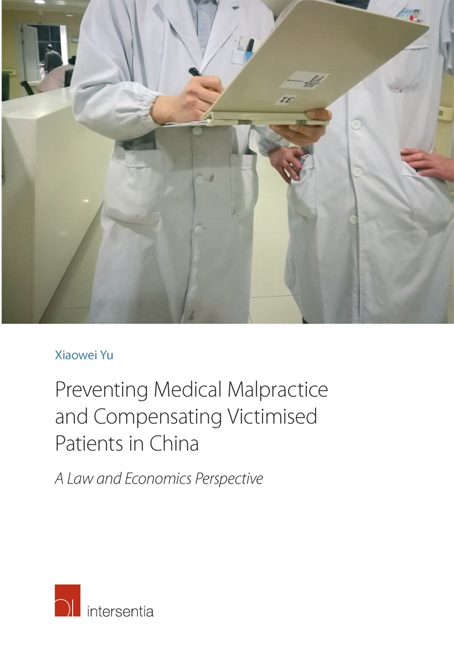 Preventing Medical Malpractice and Compensating Victimised Patients in China
Preventing Medical Malpractice and Compensating Victimised Patients in China Book contents
- Frontmatter
- Acknowledgements
- Contents
- Abbreviations
- List of Figures and Tables
- Chapter 1 Introduction
- Part I Legal Remedies for Medical Malpractice in China
- Part II Economic Theories and Empirical Evidence
- Introductory Note
- Chapter 7 Preventing Medical Errors through Tort Law – Theoretical Models
- Chapter 8 Preventing Medical Errors through Tort Law – Empirical Evidence and Updated Models
- Chapter 9 Preventing Medical Errors through Alternative Regimes
- Chapter 10 The Fault-Based Compensation Mechanisms for Iatrogenic Injuries
- Chapter 11 Medical Compensation Mechanisms Not Based on Fault
- Part III Applying the Economic Observations to China
- Summary
- Bibliography
- Appendix 1 Legislation
- Appendix 2 Cases
- Appendix 3 Semi-Structured Interviews
- Valorisation Addendum
- Curriculum Vitae
Chapter 8 - Preventing Medical Errors through Tort Law – Empirical Evidence and Updated Models
from Part II - Economic Theories and Empirical Evidence
Published online by Cambridge University Press: 29 September 2018
- Frontmatter
- Acknowledgements
- Contents
- Abbreviations
- List of Figures and Tables
- Chapter 1 Introduction
- Part I Legal Remedies for Medical Malpractice in China
- Part II Economic Theories and Empirical Evidence
- Introductory Note
- Chapter 7 Preventing Medical Errors through Tort Law – Theoretical Models
- Chapter 8 Preventing Medical Errors through Tort Law – Empirical Evidence and Updated Models
- Chapter 9 Preventing Medical Errors through Alternative Regimes
- Chapter 10 The Fault-Based Compensation Mechanisms for Iatrogenic Injuries
- Chapter 11 Medical Compensation Mechanisms Not Based on Fault
- Part III Applying the Economic Observations to China
- Summary
- Bibliography
- Appendix 1 Legislation
- Appendix 2 Cases
- Appendix 3 Semi-Structured Interviews
- Valorisation Addendum
- Curriculum Vitae
Summary
INTRODUCTION
Chapter 8 is aimed at answering the questions whether the fault-based medical malpractice liability is efficient at deterring medical errors in practice and what implications there will be for the economic model of malpractice liability after reviewing relevant empirical evidence (part of Sub-question (2- a)). Hence, in order to answer this question, it is essential to examine available empirical studies pertaining to medical malpractice issues.
The majority of the studies reviewed in this Chapter are primarily USbased. Several rounds of the “malpractice crisis” and tort reforms in the US have encouraged many scholars to research into medical malpractice issues. Hence, the largest category of the economic literature on malpractice is of empirical nature, which has developed considerably in the past two decades. Since the malpractice system in both China and the US is a fault-based tort system, these empirical findings may have high referential meaning for China. Nonetheless, empirical studies in other legal systems may also be included in the analysis if relevant.
The remainder of this Chapter is organised as follows. Section 2 will review empirical studies concerning the performance of the medical malpractice system. Section 3 will examine empirical evidence on the causes of iatrogenic injuries and point out its implications for the economic model of medical malpractice liability. The final Section 4 concludes.
EMPIRICAL EVIDENCE: IATROGENIC INJURY, MALPRACTICE LITIGATION, AND DETERRENT EFFECT
INTRODUCTION
The question with regard to the performance of medical malpractice liability can be divided into three sub-questions. First, whether the input system (liability and quantum rules) is effective as a fact, i.e. whether all meritorious claims are filed (Section 2.3) and whether the court system is effective at sorting out meritorious claims from non-meritorious claims (Section 2.4). Second, whether behavioural changes do exist and whether it is attributed to the threat of medical malpractice liability (Section 2.5). Third, whether the deterrence benefits generated by the medical malpractice system justifies the costs of the system (Section 2.6). Before that, Section 2.2 will describe the epidemiology of iatrogenic injuries in order to provide a context for subsequent discussions.
INCIDENCE, SEVERITY, AND COSTS OF IATROGENIC INJURIES
Introduction
Empirical evidence shows that iatrogenic or medical injuries are not rare events and many injuries result from substandard care in the US and elsewhere.
- Type
- Chapter
- Information
- Preventing Medical Malpractice and Compensating Victimised Patients in ChinaA Law and Economics Perspective, pp. 253 - 302Publisher: IntersentiaPrint publication year: 2017


